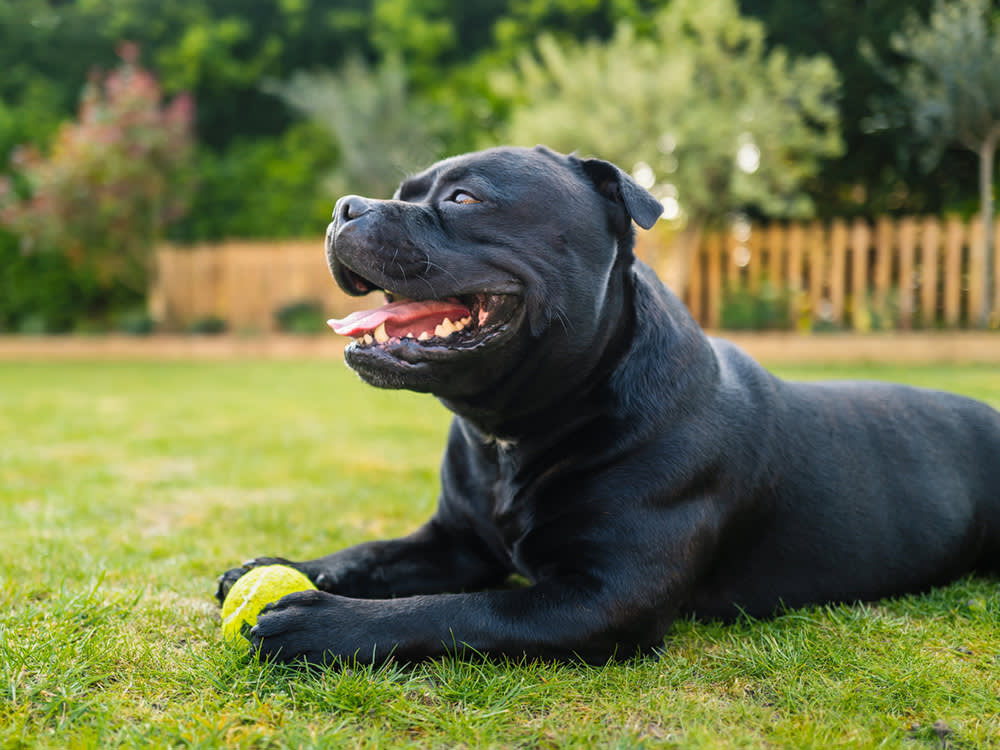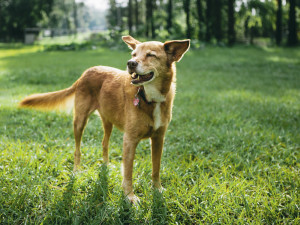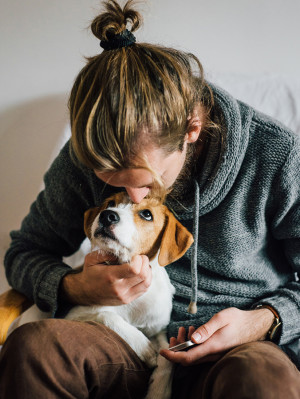Why Is Your Dog Breathing Heavy?
Don’t panic, but definitely talk to your vet if you’re worried about any of these conditions.

Share Article
In This Article:
What Are the Symptoms of Heavy Breathing in Dogs? Is Heavy Breathing in Dogs a Vet Emergency? Panting vs. Normal Breathing vs. Heavy Breathing in Dogs Types of Heavy Breathing in Dogs What Are the Causes of Heavy Breathing in Dogs? When to Be Concerned About Your Dog’s Heavy Breathing How Do Vets Diagnose Breathing Problems in Dogs? How Do You Treat Heavy Breathing in Dogs? Can You Prevent Heavy Breathing in Dogs?
Heavy breathing in dogs can be normal, but it is essential to be aware of the signs that could indicate a medical problem. If your dog is breathing heavily at rest or in situations where they would typically be calm, please take them to the vet.
What are the symptoms of heavy breathing in dogs?
Dogs can show changes in their breathing in a variety of ways. Some common things that can indicate breathing issues include:
Open-mouth breathing
Increased noise when breathing
Restlessness or inability to lay down comfortably
Abnormally deep or shallow breaths
Rapid breaths
Pale or bluish gums
Nasal discharge
Coughing or sneezing
Gasping for air (fish-mouth breathing)
Other symptoms of respiratory issues may include lethargy, hiding, loss of appetite, or fever, but these are non-specific and could be associated with a number of other conditions. Because so many respiratory issues are dangerous and can progress rapidly, it’s always best to get your dog evaluated by a veterinarian if you have any concerns that it is breathing abnormally.

Is heavy breathing in dogs a vet emergency?
Heavy breathing in dogs is absolutely an emergency. It may turn out not to be anything serious, but unusual breathing in dogs can look the same in many different conditions. Without a vet exam, you just can’t tell if it’s serious or not.
Panting vs. normal breathing vs. heavy breathing in dogs
Normal breathing in dogs
Look at your dog when resting to get an idea what normal looks like. When your dog is relaxed and not hot, stressed, excited, or exercising, they should be breathing normally. Small breeds and puppies breathe faster than other dogs. You should see:
Calm, steady, effortless breaths
About 20 to 40 breaths per minute when resting
Quiet or very soft breathing sounds
Mouth closed or slightly open
Chest gently moving in and out
Smooth and even breathing
Practice watching your dog breathing normally so you’ll recognize when it’s abnormal.
Panting in dogs
Panting in dogs is the primary way dogs cool themselves down. It’s much faster than normal breathing – over 200 breaths per minute – and involves rapid, shallow breathing with the mouth open and tongue hanging out. Normal panting should ease when a dog rests, cools off, or relaxes. It’s not usually a cause for concern unless it seems extreme or persists after the dog has cooled down.
Heavy breathing in dogs
Heavy breathing and panting are not the same. The main difference is the effort; heavy breathing involves labored, effortful breathing with exaggerated, heaving motions that look or sound abnormal. It may be noisy and include grunting, wheezing, rasping, or gasping. Your dog’s mouth may be open wide, tongue and their gums may look blue, purple, or pale, which is an emergency sign.
Heavy breathing or heavy panting can mean an emergency and you should contact your vet.
Types of heavy breathing in dogs
Dogs naturally breathe faster or harder sometimes, but heavy breathing can signal different things depending on the situation. Understanding the types can help you recognize what's normal and what's concerning.
Panting is the most common form of heavy breathing in dogs. You can fairly easily tell the difference between abnormal breathing and panting. The main difference is the effort observed.
Labored breathing is called dyspnea. Dyspnea is when breathing is physically difficult for the dog. It may involve open-mouth breathing, flared nostrils, and exaggerated chest and belly movements. The dog may stand or sit with elbows pushed outward and the neck stretched to help breathe.
Rapid breathing is referred to as tachypnea. It is fast but doesn’t have the effort seen with dyspnea. It’s usually quieter than labored breathing.
Reverse sneezing is a strange but harmless type of breathing event where dogs rapidly pull air in through the nose. It sounds like honking or choking but usually passes in a minute or two.
Noisy breathing: There are two kinds of abnormal breathing sounds: stertor, a low-pitched snoring or snuffling sound, and stridor, a high-pitched wheezing sound.
Breathing with an open mouth (but not panting).
Abdominal breathing occurs If the abdomen works hard during breathing. It usually means the chest isn't doing its job properly, which is concerning.
What are the causes of heavy breathing in dogs?
A variety of issues can make a dog breathe differently than normal. The problem is that some of the causes are benign and will resolve on their own while others are major emergencies that require veterinary care. Being familiar with some of the common causes of heavy breathing is the first step to knowing what could be going on with your dog.
Exertion
Dogs who have recently had a bout of excitement or increased activity are expected to breathe faster and harder than they would at rest. Heavy breathing from exertion should return to normal after a short rest.
Heat/humidity
Dogs dissipate excess heat primarily through their respiratory system. Panting uses evaporative cooling across the tongue and airways to cool dogs down as quickly as possible. The efficiency of this cooling is decreased in high-humidity conditions, so precautions need to be taken to limit your dog’s activity when it is hot and/or humid.
Heart issues
Heart issues can cause breathing difficulty in a number of different ways. Congestive heart failure can cause fluid to leak into a dog’s lungs, resulting in a decreased ability to absorb oxygen and increased effort required to fill the lungs with air. Heart failure (and a few other conditions) can also result in fluid accumulation in the chest or abdominal cavities. This build-up of fluid makes it difficult to expand the lungs effectively.
Lung disease
From pneumonia to cancer, problems within the lungs can impair a dog’s ability to breathe normally. Many lung issues will cause coughing and a change in a dog’s respiratory pattern. Even otherwise healthy dogs may have hidden lung abnormalitiesopens in new tab that result in a sudden onset of difficulty breathing due to air leaking into the chest cavity.
Pain/trauma
Trauma to a dog’s chest can result in broken ribs, air leakage from the lungs, bleeding in the chest, or soreness that makes it difficult for them to breathe. While a known injury to the chest is an obvious cause of heavy breathing, it may be less obvious to dog parents that pain anywhere can cause a dog to breathe differently. Dogs often pant when in pain, but some may take deliberate, shallow breaths to avoid moving the painful area.
Airway obstruction
Some causes of airway obstruction are immediately evident, as seen with a dog who unsuccessfully tries to swallow a toy. Others are more nefarious, like the chronic airway issues that plague flat-faced dogs like French and English Bulldogs.
Laryngeal paralysis, seen most commonly in large breed dogs like Labrador Retrievers, results in a partial obstruction of the trachea by the vocal cords. Its symptoms worsen with panting and often become an issue in the warmer months. In areas that have venomous snakes, curious dogs can sometimes receive a bite to the tongue that causes massive swelling, requiring emergency procedures to secure their airway.
Anxiety
Panting while at rest is a common sign of anxiety in dogs. It can be challenging to figure out what is triggering anxiety for some dogs, but getting them back into a familiar, comfortable situation should help resolve the issue.
Anemia
Dogs can develop anemia (a low red blood cell count) for a number of reasons. Red blood cells carry oxygen in the bloodstream, so dogs feel oxygen-starved when there aren’t enough cells to supply all their tissues. This triggers the body to increase the dog’s respiratory rate in an effort to get more oxygen into the bloodstream. Dogs with anemia often display a pale color to their gums and tongue.
Toxins
Certain toxins like acetaminophen and carbon monoxide affect the ability of red blood cells to bind to oxygen normally, reducing oxygen delivery to tissues and inducing rapid breathing. Gum color can vary from chocolate to cherry red to normal depending on the toxin.
Steroids
Corticosteroids can make dogs pant, even at rest. Steroid-induced panting can be seen from the administration of medications like prednisone or from the overproduction of natural steroids by the body in conditions like Cushing’s disease. Be sure to mention any medications or medical conditions your dog has to your veterinarian if you’re concerned about heavy breathing.
Parasites
Heartworms may be the most understandable of the parasites that cause dogs to breathe in a concerning way. Heartworms (Dirofilaria immitis) can lead to heartworm disease, causing:
Coughing
Exercise intolerance
Labored or rapid breathing (especially in advanced stages)
Fluid buildup in the lungs (pulmonary edema)
Right-sided heart failure
Dogs with heavy breathing due to heartworm disease often have a chronic, dry cough and show signs of respiratory distress, especially after exercise or excitement.
Other parasites can also cause heavy breathing. Lungworms (e.g., Oslerus osleri, Crenosoma vulpis, Angiostrongylus vasorum) live in the lungs or airways, and infection from them can result in chronic cough, wheezing, nasal discharge, increased respiratory effort, or heavy breathing. While roundworms, hookworms, and whipworms are intestinal, they can still impact respiration in specific cases. For example, in cases of roundworms, larvae migrate through the lungs during development (especially in puppies), causing pneumonia, coughing, and increased respiratory rate. Severe anemia from blood-feeding parasites such as hookworms can reduce oxygen-carrying capacity and cause tachypnea (rapid breathing), lethargy, and pale gums.
In rare cases, flea allergy dermatitis or hypersensitivity reactions can cause an anaphylactic response. Tick-borne diseases (e.g., Ehrlichiosis, Babesiosis) may result in anemia or respiratory signs in advanced cases.
How do I determine whether my dog’s breathing is abnormal?
Differentiating expected alterations and abnormal changes in a dog’s breathing can be challenging. If you’re ever in doubt about your dog’s breathing, it’s best to have them seen by a veterinarian. It’s better to get reassurance that things are fine than to miss out on catching a problem early.
Many pet parents worry about their dog hyperventilating after activity outside, especially during the summer months or on the first warm day of the year. Panting is a normal and expected response to activity in increased heat, but it can also indicate a problem if it is persistent. Make sure your dog’s panting resolves quickly after any activity once they’re calm and in a cool area. Rapid or noisy panting that is persistent should always cause concern.
A common sign of respiratory distress in dogs is restlessness. Many dogs having difficulty breathing will not be able to settle down comfortably and will pace the room while breathing harder or more rapidly than normal. Once a dog is resting, their respiratory rate should be less than 30 breaths per minuteopens in new tab. It’s often easiest to count the number of times they breathe in 30 seconds and multiply by two to get their respiratory rate.
When to be concerned about your dog’s heavy breathing
It's not an emergency every time your dog breathes a little hard, but you should watch out for some common red flags before deciding things are OK. Some things to check for when your dog displays heavy breathing include:
Gums or tongue that are any color but bubble gum pink, especially a pale or bluish color (this may be hard to see on dogs with pigmented gums)
Persistent panting or rapid breathing without an obvious cause
Abnormal breathing accompanied by coughing
Fluid coming from the nose or mouth
Heavy breathing at rest with no recent activity
Any signs of distress (panicked look, restlessness, attention-seeking, hiding)
Swelling in or around the mouth, throat, or face
Any signs of pain
Increased noise when breathing
Weakness
It’s impossible to list every subtle sign that may call for a high level of concern when fast breathing in a dog has been noted. You know your dog better than anyone, so you should get them checked out if you feel something is off. Taking a video of abnormal breathing or behavior can help your vet to diagnose the problem, because some dogs will hide their symptoms during the excitement of a car ride and vet visit.
How do vets diagnose breathing problems in dogs?
The first step in diagnosing breathing problems in a dog is observing their respiratory pattern. Veterinarians can often determine the general area of the problem (upper airway, lungs, chest cavity, or other) just by watching the pattern of a dog’s breathing. Careful auscultation (listening with a stethoscope) can also help localize the problem, and the type of sounds heard may give clues about the cause.
After the physical examination, imaging may be recommended. Chest radiographs (X-rays) have been the mainstay of diagnosis for years. They can give your veterinarian a good idea of what is going on in the chest cavity and within the lungs. Ultrasound of the chest is often performed in emergency situations. While it may not give all the information that a chest radiograph does, it is a much less stressful test for dogs in severe distress.
Complementary tests like pulse oximetry, blood gas analysis, a complete blood count, and blood chemistry can give a more complete picture of what could be causing a dog’s heavy breathing. If the initial imaging isn’t definitive in diagnosing or showing the extent of the problem, advanced procedures like an MRI or bronchoscopy may be recommended as long as the dog is stable enough for it.
How do you treat heavy breathing in dogs?
The treatment of fast breathing in a dog will depend on the cause. If a dog with heavy breathing is in any distress, getting them additional oxygen is key. This can be provided by a number of methods, including holding an oxygen line up to their face, putting them in a cage that contains a higher concentration of oxygen, or placing a small tube into their nose to deliver oxygen to the back of their throat.
Many veterinarians will administer a mild sedative to reduce a dog’s stress and anxiety while they’re being treated. This can also help by reducing their body’s oxygen demand. Calm dogs need less oxygen because they have less overall muscle activity.
Heart conditions often require medications such as diuretics and drugs that strengthen heart contractions to help dogs breathe more easily. Other respiratory issues may be treated with antibiotics, cough suppressants, steroids, pain control, anti-anxiety medications, or surgery. Getting to the bottom of what is causing the abnormal breathing is vital to initiating appropriate treatment.
Can you prevent heavy breathing in dogs?
Some causes of heavy breathing can be prevented by informed and proactive pet parents. Other causes cannot be prevented but may be delayed by regular veterinary care that finds and addresses possible issues before they develop into major problems. Some general tips to prevent episodes of heavy breathing include:
Avoid exercising your dog in extreme heat or humidity.
Ramp up activity gradually – don't try to make your dog go from a couch potato to an athlete in one day.
Make sure your dog is at a healthy weight.
Manage any underlying medical conditions that your dog may have.
Do not administer any human medications to your dog and keep them away from toxins.
Keep up-to-date on preventative care.
Have your dog checked regularly by your veterinarian for any health concerns.
Bottom line: heavy breathing in dogs
It can be difficult to interpret what it means when your dog breathes strangely. That’s why it’s important for you to learn what’s normal. The best way to know what’s abnormal is to know what’s normal. There are so many conditions that can affect a dog’s respiration. If your dog isn’t breathing like usual, talk to your vet immediately. With a thorough exam and possibly some tests, a diagnosis can be determined. The earlier a condition is diagnosed, the earlier treatment can begin and the better the outcome.
FAQs
Can hot weather cause heavy breathing in dogs?
Hot weather can cause heavy breathing in dogs as they try to dissipate extra heat by panting. If you feel your dog is breathing heavier than usual, get them into a cool, dry area and calm them down quickly.
Can heavy breathing be a sign of pain in dogs?
Pain can cause heavy breathing in dogs. Trauma to the chest or airway can obviously cause breathing issues, but pain anywhere in the body can cause a dog to pant and act abnormally.
How to calm a dog with heavy breathing?
Assess the situation. Is it just panting? Dogs pant to cool down, especially after exercise or in heat. This can be normal.
Is it true heavy breathing (labored, distressed)? If it looks like your dog is struggling (wide open mouth, flaring nostrils, deep heaving breaths, or pale/blue gums), you need to call a veterinarian immediately.
If it seems more like anxiety, overheating, or mild exertion, you can proceed to help them calm down.
Get indoors or into the shade if outside.
Turn on a fan or air conditioning.
Offer water, but don't force your dog to drink.
If it's heat-related, gently wet their paws, belly, and ears with cool (not ice-cold) water to help with cooling.
Use a calm voice and gentle touch.
Give them space.
Breathe loudly, but normally yourself. Your dog may pick up on your breathing pattern.
Speak softly and avoid sudden movements.
Gently pet or stroke your dog.
Avoid crowding them.
Offer a favorite toy, a treat puzzle, or chew for distraction.
Play calming music made for dogs.
Try Adaptil diffusers or sprays.
Give calming chews with ingredients like L-theanine, melatonin, or chamomile.
Use a weighted anxiety wrap like a ThunderShirt.
If the heavy breathing improves within 10 to 15 minutes of rest and cooling down, that's a good sign. If it worsens, persists, or is paired with signs such as pale or bluish gums, collapse, weakness, vomiting, coughing, strange noises while breathing then you need to seek emergency veterinary care immediately.
What is belly breathing in dogs?
If your dog’s abdomen rises and falls when breathing, instead of just the chest alone, that is known as belly breathing. This is also known as diaphragmatic breathing. If your dog is relaxed, it can be normal. If it’s exaggerated or excessive, it can be a sign of respiratory problems and you should speak to your vet right away.
What is considered rapid breathing in dogs?
Normal breathing is between 20 and 40 breaths per minute. Anything higher than that would be considered rapid breathing, although if your dog is scared or excited, the breathing rate can be a bit higher without the need for concern.
References:
Ainsworth, D. M., et al. “Breathing during Exercise in Dogs--Passive or Active?” Journal of Applied Physiology, vol. 81, no. 2, 1 Aug. 1996, pp. 586–595, https://journals.physiology.org/doi/abs/10.1152/jappl.1996.81.2.586opens in new tab
Amis, Terence C, and C. Kurpershoek. “Pattern of Breathing in Brachycephalic Dogs.” American Journal of Veterinary Research, vol. 47, no. 10, 1 Oct. 1986, pp. 2200–2204, https://avmajournals.avma.org/view/journals/ajvr/47/10/ajvr.1986.47.10.2200.xmlopens in new tab
Whitteridge, D. “MULTIPLE EMBOLISM of the LUNG and RAPID SHALLOW BREATHING.” Physiological Reviews, vol. 30, no. 4, 1 Oct. 1950, pp. 475–486, https://journals.physiology.org/doi/abs/10.1152/physrev.1950.30.4.475opens in new tab

Dr. Bartley Harrison, DVM
Dr. Bartley Harrison is a veterinarian with more than 19 years of experience. He has treated a variety of species in emergency and speciality practices for both large and small animals. His primary interests as a vet are emergency medicine and critical care.

Dr. Shelby Neely, DVM
Dr. Shelby Neely is a freelance writer and veterinarian who graduated from the University of Pennsylvania School of Veterinary Medicine and has practiced veterinary medicine for 30 years, specializing in small animals. Her work has appeared in Allivet, AsktheCatDoctor, WhiskerDocs, Ask the Cat Doctor Radio, Ask the Cat Doctor TV, and numerous other websites, brochures, newsletters, newspapers, and ebooks. In her spare time, Dr. Neely likes to spend time with her three children, two grandchildren, three cats, two grand-cats, and five grand-dogs.
Related articles
![French bulldog puppy looking scared at vet]()
10 Things to Ask at Your First Vet Visit
There are no stupid questions — well, when it comes to your dog’s health.
![A happy woman is lying on a bed, her dog smelling her face.]()
9 Diseases You Can (and Definitely Can’t) Catch From Your Dog
Here’s what you can scratch off your “Worry About This” list.
![Man Kissing And Hugging a small white and brown dog.]()
A Mysterious Illness Is Making Dogs Across the Country Sick
Get all the info about this highly contagious respiratory illness—including its possible origins.
![Australian shepherd panting with tongue out, walking ahead of owners.]()
How to Keep Your Pets Safe During Extreme Heat Waves
As scorching, long-lasting temperatures become the new normal, here’s how to help keep your pets cool and healthy.
Why Does My Puppy Breathe Fast While Sleeping?
And is it normal?
Can Dogs Get Congested?
How to look out for the signs your pup is feeling stuffed up.






